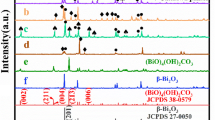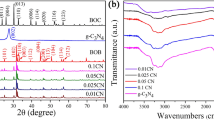Abstract
Bismuth (Bi)-based photocatalytic materials are widely used in the field of photocatalytic degradation of wastewater. In this study, β-Bi2O3/BiOBr heterojunction photocatalysts were prepared by an in situ chemical transformation method. BiOBr molecules are arrayed to cross each other to form a pore around β-Bi2O3. The prepared photocatalyst had a large specific surface area and excellent adsorption and photocatalytic properties. The β-Bi2O3/BiOBr with a molecular ratio of 11.1% had the highest catalytic activity. The result of a degradation experiment, performed with Rhodamine B (RhB) as the target pollutant, revealed that the degradation rate reached 99.85% after 25 min under visible light irradiation. The pore structure can adsorb contaminants and the heterojunction facilitates the separation of photogenerated electron–hole pairs to enhance the photocatalytic properties. The high adsorption performance and heterojunction achieved higher photocatalytic efficiency. This semiconductor photocatalyst with high adsorption performance provides a new approach to control water pollution.










Similar content being viewed by others
References
X. Li, J. Yu, M. Jaroniec, and X. Chen: Cocatalysts for selective photoreduction of CO2 into solar fuels. Chem. Rev. 119, 3962–4179 (2019).
B. Qiao, Y. Chen, M. Tian, H. Wang, F. Yang, G. Shi, L. Zhang, C. Peng, Q. Luo, and S. Ding: Characterization of water soluble inorganic ions and their evolution processes during PM2.5 pollution episodes in a small city in southwest China. Sci. Total Environ. 650, 2605–2613 (2019).
J. Xue and K. Kannan: Mass flows and removal of eight bisphenol analogs, bisphenol A diglycidyl ether and its derivatives in two wastewater treatment plants in New York State, USA. Sci. Total Environ. 648, 442–449 (2019).
T. Kameda, S. Ito, and T. Yoshioka: Kinetic and equilibrium studies of urea adsorption onto activated carbon: Adsorption mechanism. J. Dispersion Sci. Technol. 38, 1063–1066 (2016).
E. GilPavas, I. Dobrosz-Gomez, and M.A. Gomez-Garcia: Optimization and toxicity assessment of a combined electrocoagulation, H2O2/Fe2+/UV and activated carbon adsorption for textile wastewater treatment. Sci. Total Environ. 651, 551–560 (2019).
I.K. Konstantinou and T.A. Albanis: TiO2-assisted photocatalytic degradation of azo dyes in aqueous solution: Kinetic and mechanistic investigations. Appl. Catal., B 49, 1–14 (2004).
C.S. Turchi and D.F. Ollis: Photocatalytic degradation of organic water contaminants: Mechanisms involving hydroxyl radical attack. J. Catal. 122, 178–192 (1990).
Y. Xie, Z. Huang, Z. Zhang, X. Zhang, R. Wen, Y. Liu, M. Fang, and X. Wu: Controlled synthesis and photocatalytic properties of rhombic dodecahedral Ag3PO4 with high surface energy. Appl. Surf. Sci. 389, 56–66 (2016).
J. Han, Y. Liu, N. Singhal, L. Wang, and W. Gao: Comparative photocatalytic degradation of estrone in water by ZnO and TiO2 under artificial UVA and solar irradiation. Chem. Eng. J. 213, 150–162 (2012).
X. Yan, X. Yuan, J. Wang, Q. Wang, C. Zhou, D. Wang, H. Tang, J. Pan, and X. Cheng: Construction of novel ternary dual Z-scheme Ag3VO4/C3N4/reduced TiO2 composite with excellent visible-light photodegradation activity. J. Mater. Res. 34, 2024–2036 (2019).
X. Ding, W. Wang, A. Zhang, L. Zhang, and D. Yu: Efficient visible light degradation of dyes in wastewater by nickel–phosphorus plating–titanium dioxide complex electroless plating fabric. J. Mater. Res. 34, 999–1010 (2019).
D. Mohan and C.U. Pittman, Jr.: Arsenic removal from water/wastewater using adsorbents—A critical review. J. Hazard. Mater. 142, 1–53 (2007).
X. Wu, Y. Hu, Y. Wang, Y. Zhou, Z. Han, X. Jin, and G. Chen: In situ synthesis of Z-scheme Ag2CO3/Ag/AgNCO heterojunction photocatalyst with enhanced stability and photocatalytic activity. Appl. Surf. Sci. 464, 108–114 (2019).
N. Wada, Y. Yokomizo, C. Yogi, M. Katayama, A. Tanaka, K. Kojima, Y. Inada, and K. Ozutsumi: Effect of adding Au nanoparticles to TiO2 films on crystallization, phase transformation, and photocatalysis. J. Mater. Res. 33, 467–481 (2018).
S. Challagulla and S. Roy: The role of fuel to oxidizer ratio in solution combustion synthesis of TiO2 and its influence on photocatalysis. J. Mater. Res. 32, 2764–2772 (2017).
L. Zammouri, A. Aboulaich, B. Capoen, M. Bouazaoui, M. Sarakha, M. Stitou, and R. Mahiou: Synthesis of YAG:Ce/ZnO core/shell nanoparticles with enhanced UV-visible and visible light photocatalytic activity and application for the antibiotic removal from aqueous media. J. Mater. Res. 34, 1318–1330 (2019).
S. Liu, Y. Wang, L. Ma, and H. Zhang: Ni2P/ZnS (CdS) core/shell composites with their photocatalytic performance. J. Mater. Res. 33, 3580–3588 (2018).
X. Gao, W. Peng, G. Tang, Q. Guo, and Y. Luo: Highly efficient and visible-light-driven BiOCl for photocatalytic degradation of carbamazepine. J. Alloys Compd. 757, 455–465 (2018).
S.Y. Chai, Y.J. Kim, M.H. Jung, A.K. Chakraborty, D. Jung, and W.I. Lee: Heterojunctioned BiOCl/Bi2O3, a new visible light photocatalyst. J. Catal. 262, 144–149 (2009).
A. Han, J. Sun, G.K. Chuah, and S. Jaenicke: Enhanced p-cresol photodegradation over BiOBr/Bi2O3 in the presence of rhodamine B. RSC Adv. 7, 145–152 (2017).
H. Lu, Q. Hao, T. Chen, L. Zhang, D. Chen, C. Ma, W. Yao, and Y. Zhu: A high-performance Bi2O3/Bi2SiO5 p–n heterojunction photocatalyst induced by phase transition of Bi2O3. Appl. Catal., B 237, 59–67 (2018).
J. Qin, N. Chen, C. Feng, H. Chen, M. Li, and Y. Gao: Fabrication of a narrow-band-gap Ag6Si2O7/BiOBr composite with high stability and enhanced visible-light photocatalytic activity. Catal. Lett. 148, 2777–2788 (2018).
Y. Xie, S. Luo, H. Huang, Z. Huang, Y. Liu, M. Fang, X. Wu, and X. Min: Construction of an Ag3PO4 morphological homojunction for enhanced photocatalytic performance and mechanism investigation. Colloids Surf., A 546, 99–106 (2018).
J. Low, J. Yu, M. Jaroniec, S. Wageh, and A.A. Al-Ghamdi: Heterojunction photocatalysts. Adv. Mater. 29, 1601694 (2017).
L. Wang, H. Liu, H. Fu, Y. Wang, K. Yu, and S. Wang: Polymer g-C3N4 wrapping bundle-like ZnO nanorod heterostructures with enhanced gas sensing properties. J. Mater. Res. 33, 1401–1410 (2018).
Y. Sun, J. Liao, F. Dong, S. Wu, and L. Sun: A Bi/BiOI/(BiO)2CO3 heterostructure for enhanced photocatalytic NO removal under visible light. Chin. J. Catal. 40, 362–370 (2019).
H. Zhong, Y. Qiu, T. Zhang, X. Li, H. Zhang, and X. Chen: Bismuth nanodendrites as high performance electrocatalyst for selective conversion of CO2 to formate. J. Mater. Chem. A 4, 13746–13753 (2016).
H. Li, H. Zhu, M. Wang, X. Min, M. Fang, Z. Huang, Y.g. Liu, and X. Wu: A new Ag/Bi7Ta3O18 plasmonic photocatalyst with a visible-light-driven photocatalytic activity. J. Mater. Res. 32, 3650–3659 (2017).
Z. Feng, L. Zeng, Y. Chen, Y. Ma, C. Zhao, R. Jin, Y. Lu, Y. Wu, and Y. He: In situ preparation of Z-scheme MoO3/g-C3N4 composite with high performance in photocatalytic CO2 reduction and RhB degradation. J. Mater. Res. 32, 3660–3668 (2017).
R. He, D. Xu, B. Cheng, J. Yu, and W. Ho: Review on nanoscale Bi-based photocatalysts. Nanoscale Horiz. 3, 464–504 (2018).
H.J. Jung, S. Park, K.D. Kim, T.H. Kim, M.Y. Choi, and K.Y. Lee: Fabrication of porous β-Bi2O3 nanoplates by phase transformation of bismuth precursor via low-temperature thermal decomposition process and their enhanced photocatalytic activity. Colloids Surf., A 550, 37–45 (2018).
L. Zhou, W. Wang, H. Xu, S. Sun, and M. Shang: Bi2O3 hierarchical nanostructures: Controllable synthesis, growth mechanism, and their application in photocatalysis. Chem.–Eur. J. 15, 1776–1782 (2009).
J. Li, Y. Yu, and L. Zhang: Bismuth oxyhalide nanomaterials: Layered structures meet photocatalysis. Nanoscale 6, 8473–8488 (2014).
H-T. Wang, M-S. Shi, H-F. Yang, N. Chang, H. Zhang, Y-P. Liu, M-C. Lu, D. Ao, and D-Q. Chu: Template-free synthesis of nanosliced BiOBr hollow microspheres with high surface area and efficient photocatalytic activity. Mater. Lett. 222, 164–167 (2018).
X. Zhang, Z. Ai, F. Jia, and L. Zhang: Generalized one-pot synthesis, characterization, and photocatalytic activity of hierarchical BiOX (X = Cl, Br, I) nanoplate microspheres. J. Phys. Chem. C 112, 747–753 (2008).
S. Liu, M. Zhao, Z. He, Y. Zhong, H. Ding, and D. Chen: Preparation of a p–n heterojunction 2D BiOI nanosheet/1DBiPO4 nanorod composite electrode for enhanced visible light photoelectrocatalysis. Chin. J. Catal. 40, 446–457 (2019).
Y. Liang, C. Guo, S. Cao, Y. Tian, and Q. Lui: A high quality BiOCl film with petal-like hierarchical structures and its visible-light photocatalytic property. J. Nanosci. Nanotechnol. 13, 919–923 (2013).
F. Zhang, L. Wang, M. Xiao, F. Liu, X. Xu, and E. Du: Construction of direct solid-state Z-scheme g-C3N4/BiOI with improved photocatalytic activity for microcystin-LR degradation. J. Mater. Res. 33, 201–212 (2017).
F. Chen, Q. Yang, F. Yao, Y. Ma, Y. Wang, X. Li, D. Wang, L. Wang, and H. Yu: Synergetic transformations of multiple pollutants driven by BiVO4-catalyzed sulfite under visible light irradiation: Reaction kinetics and intrinsic mechanism. Chem. Eng. J. 355, 624–636 (2019).
Q. Wang, H. Jiang, S. Ding, H.M. Noh, B.K. Moon, B.C. Choi, J. Shi, and J.H. Jeong: Butterfly-like BiVO4: Synthesis and visible light photocatalytic activity. Synth. React. Inorg. Met.–Org. Chem. 46, 483–488 (2015).
S. Han, J. Li, K. Yang, and J. Lin: Fabrication of a β-Bi2O3/BiOI heterojunction and its efficient photocatalysis for organic dye removal. Chin. J. Catal. 36, 2119–2126 (2015).
X. Li, J. Xie, C. Jiang, J. Yu, and P. Zhang: Review on design and evaluation of environmental photocatalysts. Front. Environ. Sci. Eng. 12, 14 (2018).
J. Wang, L. Ren, D. Zhang, X. Hao, J. Gong, X. Xiao, Y. Jiang, and Z. Tong: Fabrication of Bi2MoO6/BiOI heterojunction photocatalysts for enhanced photodegradation of RhB. J. Mater. Res. 33, 3928–3935 (2018).
S. You, Y. Hu, X. Liu, and C. Wei: Synergetic removal of Pb(II) and dibutyl phthalate mixed pollutants on Bi2O3–TiO2 composite photocatalyst under visible light. Appl. Catal., B 232, 288–298 (2018).
Y. Miao, Z. Lian, Y. Huo, and H. Li: Microwave-assisted ionothermal synthesis of hierarchical microcube-like BiOBr with enhanced photocatalytic activity. Chin. J. Catal. 39, 1411–1417 (2018).
L. Shan, Y. Liu, H. Chen, Z. Wu, and Z. Han: An α-Bi2O3/BiOBr core–shell heterojunction with high photocatalytic activity. Dalton Trans. 46, 2310–2321 (2017).
S. Cipagauta-Díaz, A. Estrella-González, and R. Gómez: Heterojunction formation on InVO4/N-TiO2 with enhanced visible light photocatalytic activity for reduction of 4-NP. Mater. Sci. Semicond. Process. 89, 201–211 (2019).
Y. Guo, Y. Dai, W. Zhao, H. Li, B. Xu, and C. Sun: Highly efficient photocatalytic degradation of naphthalene by Co3O4/Bi2O2CO3 under visible light: A novel p–n heterojunction nanocomposite with nanocrystals/lotus-leaf-like nanosheets structure. Appl. Catal., B 237, 273–287 (2018).
J. Yan, M. Xu, B. Chai, H. Wang, C. Wang, and Z. Ren: In situ construction of BiOBr/Ag3PO4 composites with enhanced visible light photocatalytic performances. J. Mater. Res. 32, 1603–1610 (2017).
X. Tang, Z. Wang, N. Wu, S. Liu, and N. Liu: A novel visible-light-active β-Bi2O3/BiOBr heterojunction photocatalyst with remarkably enhanced photocatalytic activity. Catal. Commun. 119, 119–123 (2019).
X. Liu, C. Sun, Y. Yue, T. Yan, Y. He, Y. Yu, W. Li, W. Wang, K. Zhu, and Z. Jing: Synthesis and characterization of three-dimensional sea urchin-like AgBr/TiO2 microspheres with enhanced antibacterial and visible-light photocatalytic performance. Chem. Pap. 73, 1971–1978 (2019).
G. Lei: Novel visible-light-driven Pt/BiVO4 photocatalyst for efficient degradation of methyl orange. J. Mol. Catal. A: Chem. 282, 62–66 (2008).
Y. Ohko, D.A. Tryk, K. Hashimoto, and A. Fujishima: Autoxidation of acetaldehyde initiated by TiO2 photocatalysis under weak UV illumination. J. Phys. Chem. B 102, 2699–2704 (1998).
L. Shan, G. Wang, D. Li, X. San, L. Liu, L. Dong, and Z. Wu: Band alignment and enhanced photocatalytic activation of alpha/beta-Bi2O3 heterojunctions via in situ phase transformation. Dalton Trans. 44, 7835–7843 (2015).
T. Hu, Y. Yang, K. Dai, J. Zhang, and C. Liang: A novel Z-scheme Bi2MoO6/BiOBr photocatalyst for enhanced photocatalytic activity under visible light irradiation. Appl. Surf. Sci. 456, 473–481 (2018).
H-Y. Jiang, P. Li, G. liu, J. Ye, and J. Lin: Synthesis and photocatalytic properties of metastable β-Bi2O3 stabilized by surface-coordination effects. J. Mater. Chem. A 3, 5119–5125 (2015).
Acknowledgments
This present work was supported by the Fundamental Research Funds for the Central Universities for financial support (Grant Nos. 2652018325, 2652018321, and 2652018320) and National Key R&D Program of China (Grant No. 2018YFC190503).
Author information
Authors and Affiliations
Corresponding authors
Supplementary Material
Rights and permissions
About this article
Cite this article
Wu, S., Xie, Y., Zhang, X. et al. In situ synthesis of adsorptive β-Bi2O3/BiOBr photocatalyst with enhanced degradation efficiency. Journal of Materials Research 34, 3450–3461 (2019). https://doi.org/10.1557/jmr.2019.243
Received:
Accepted:
Published:
Issue Date:
DOI: https://doi.org/10.1557/jmr.2019.243




